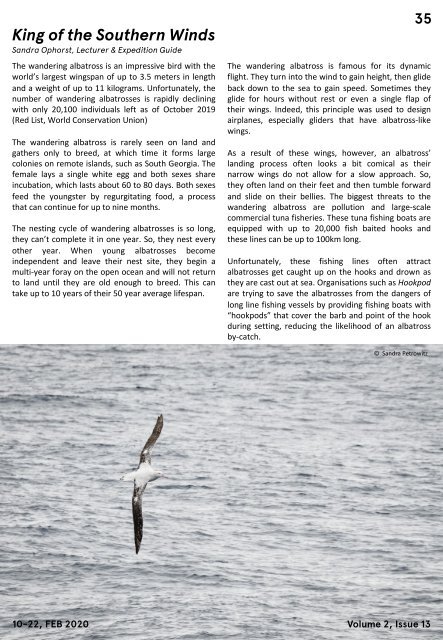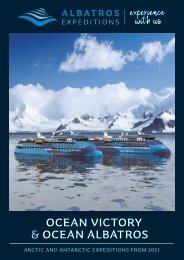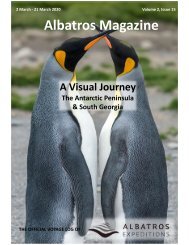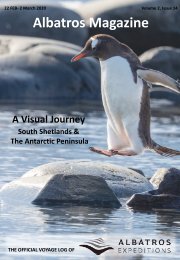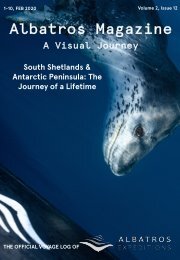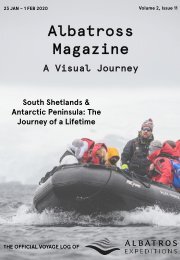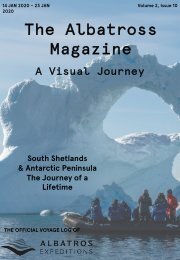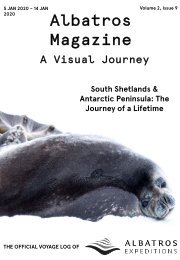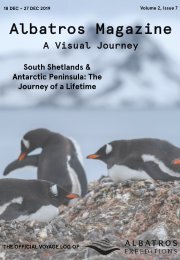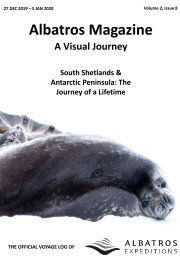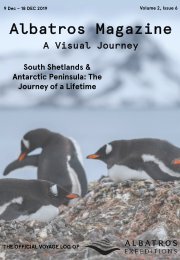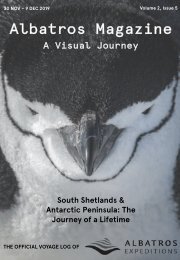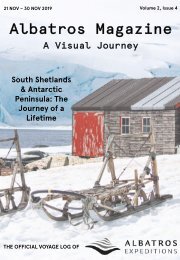Antarctic Peninsula and Polar Circle 2020 Feb 10 2020 -13
You also want an ePaper? Increase the reach of your titles
YUMPU automatically turns print PDFs into web optimized ePapers that Google loves.
King of the Southern Winds<br />
S<strong>and</strong>ra Ophorst, Lecturer & Expedition Guide<br />
The w<strong>and</strong>ering albatross is an impressive bird with the<br />
world’s largest wingspan of up to 3.5 meters in length<br />
<strong>and</strong> a weight of up to 11 kilograms. Unfortunately, the<br />
number of w<strong>and</strong>ering albatrosses is rapidly declining<br />
with only 20,<strong>10</strong>0 individuals left as of October 2019<br />
(Red List, World Conservation Union)<br />
The w<strong>and</strong>ering albatross is rarely seen on l<strong>and</strong> <strong>and</strong><br />
gathers only to breed, at which time it forms large<br />
colonies on remote isl<strong>and</strong>s, such as South Georgia. The<br />
female lays a single white egg <strong>and</strong> both sexes share<br />
incubation, which lasts about 60 to 80 days. Both sexes<br />
feed the youngster by regurgitating food, a process<br />
that can continue for up to nine months.<br />
The nesting cycle of w<strong>and</strong>ering albatrosses is so long,<br />
they can’t complete it in one year. So, they nest every<br />
other year. When young albatrosses become<br />
independent <strong>and</strong> leave their nest site, they begin a<br />
multi-year foray on the open ocean <strong>and</strong> will not return<br />
to l<strong>and</strong> until they are old enough to breed. This can<br />
take up to <strong>10</strong> years of their 50 year average lifespan.<br />
35<br />
The w<strong>and</strong>ering albatross is famous for its dynamic<br />
flight. They turn into the wind to gain height, then glide<br />
back down to the sea to gain speed. Sometimes they<br />
glide for hours without rest or even a single flap of<br />
their wings. Indeed, this principle was used to design<br />
airplanes, especially gliders that have albatross-like<br />
wings.<br />
As a result of these wings, however, an albatross’<br />
l<strong>and</strong>ing process often looks a bit comical as their<br />
narrow wings do not allow for a slow approach. So,<br />
they often l<strong>and</strong> on their feet <strong>and</strong> then tumble forward<br />
<strong>and</strong> slide on their bellies. The biggest threats to the<br />
w<strong>and</strong>ering albatross are pollution <strong>and</strong> large-scale<br />
commercial tuna fisheries. These tuna fishing boats are<br />
equipped with up to 20,000 fish baited hooks <strong>and</strong><br />
these lines can be up to <strong>10</strong>0km long.<br />
Unfortunately, these fishing lines often attract<br />
albatrosses get caught up on the hooks <strong>and</strong> drown as<br />
they are cast out at sea. Organisations such as Hookpod<br />
are trying to save the albatrosses from the dangers of<br />
long line fishing vessels by providing fishing boats with<br />
“hookpods” that cover the barb <strong>and</strong> point of the hook<br />
during setting, reducing the likelihood of an albatross<br />
by-catch.<br />
© S<strong>and</strong>ra Petrowitz<br />
<strong>10</strong>-22, FEB <strong>2020</strong><br />
Volume 2, Issue <strong>13</strong>


